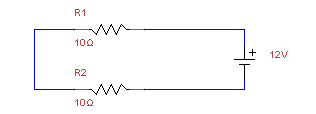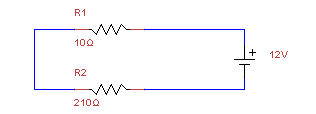The below circuit has two resistors, R1 and R2, each with a resistance of 10 ohms with a 12v power source. If we wanted to
know what the voltage is after each resistor, or what the voltage drop is, we can calculate it.

Our total resistance, by the rules stated above in a series circuit is 20 ohms (R1+R2=R). Now we have the E and I of ohms law, we can get the total amperage. I=V/R I = 12/20 I = 0.6 Amps
Now that we know the totals of all the circuits, we can calculate the voltage drop after each resistor, which we will call V1 and V2. V1 = 0.6A x 10 Ohms = 6V V2 = 0.6A x 10 Ohms = 6V
This is important because if you had a component that needed 10V to function, it would not after one of these resistors.
Lets see what happens when we change R2 to a larger resistor.

We will need to calculate the total resistance again, which in this case is 15 ohms (R1+R2=R). Our total amperage will be different as well. I=V/R I = 12/210 I = 0.057 Amps
Now for the voltage drops V1 = 0.057A x 10 Ohms = .5V V2 = 0.057A x 210 Ohms = 11.97 V

